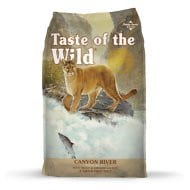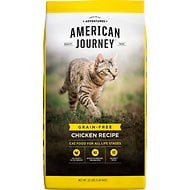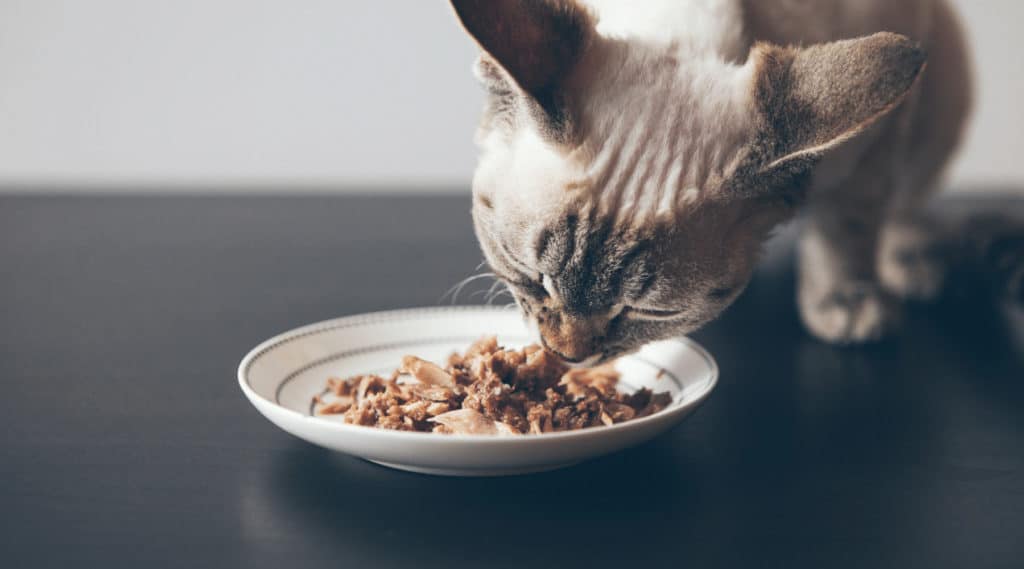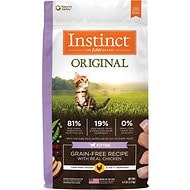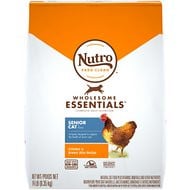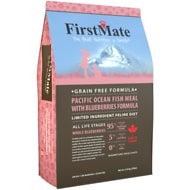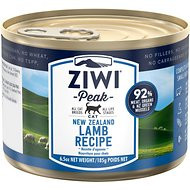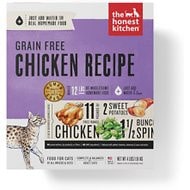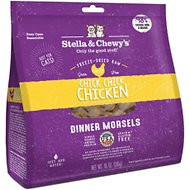Contents
- What Is The Best Cat Food Without Carrageenan?
- What is Carrageenan, Anyway?
- What You Need to Know About Carrageenan in Cat Food
- What Should You Look for in a Healthy Cat Food?
- How Do We Make Cat Food Recommendations?
- The 10 Best Cat Foods Without Carrageenan
- Smalls Ground Bird Fresh Human-Grade Cat Food
- Taste of the Wild Canyon River Grain-Free Dry Food
- American Journey Chicken Recipe Grain-Free Dry
- Instinct by Nature’s Variety Original Kitten Grain-Free Recipe with Real Chicken Dry Food
- Nutro Wholesome Essentials Chicken & Brown Rice Recipe Senior Dry Cat Food
- FirstMate Pacific Ocean Meal with Blueberries Formula Limited Ingredient Diet Grain-Free Dry Food
- 4 More Top-Rated Cat Foods without Carrageenan
- Frequently Asked Questions
When you pick up a bag of cat food and see the word “natural” on the label, you probably assume that it’s pretty good. If you check the ingredients list and don’t see anything glaringly wrong, you think you’re safe. What you may not realize is that even natural ingredients can be harmful. Carrageenan is one.
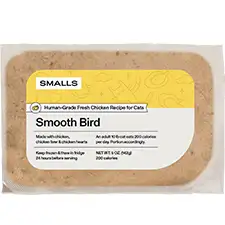
Smalls Smooth Bird Fresh Human-Grade Cat Food
- Natural sources of taurine
- High in protein
Carrageenan is a type of thickener used in pet foods (primarily wet food) and it is derived from a type of seaweed. Though completely natural, this thickener has been linked to serious health problems and it’s not the only thing to worry about. Other potentially harmful ingredients in cat food that are technically natural include corn syrup, soy products, and cellulose.
In this article, we’ll talk about carrageenan in cat food including what it is and what problems it can cause. You’ll also learn what you need to look for in a healthy cat food and see our top picks for the best carrageenan free cat food.
What Is The Best Cat Food Without Carrageenan?
- Smalls Fresh Bird Human-Grade Cat Food – Healthiest!
- Taste of the Wild Canyon River Grain-Free Dry Food
- American Journey Chicken Recipe Grain-Free Dry
- Instinct by Nature’s Variety Original Kitten Grain-Free
- Nutro Wholesome Essentials Chicken & Brown Rice
- FirstMate Pacific Ocean Meal with Blueberries
- Ziwi Peak Lamb Recipe Canned Food
- Halo Holistic Seafood Medley Sensitive Stomach
- The Honest Kitchen Grain-Free Chicken Recipe
- Stella & Chewy’s Chick Chick Chicken Dinner
What is Carrageenan, Anyway?
Carrageenan is a food additive used to thicken, emulsify and preserve foods. It’s technically a natural ingredient derived from red seaweed or Irish moss and it is common in human foods like meat products, nut milks, and yogurt.
Though carrageenan has been used for years, it has been something of a controversy since the 1960s. Some evidence shows a link with inflammation, gastrointestinal ulcers, and damage to the digestive system. It has also been linked with glucose intolerance, bloating, colon cancer, and food allergies in humans. But what about pets?
In addition to being a human food additive, carrageenan is also used in pet for similar applications. It is considered indigestible with no nutritional value, but that’s not the problem. The same issues it causes in humans can also be seen in pets. Read on to learn more.
What You Need to Know About Carrageenan in Cat Food
When it comes to cat food, there are two primary categories: canned food and dry food. As you can imagine, dry food doesn’t have the same need for thickening agents as wet food. For that reason, you’ll find carrageenan and other thickeners primarily in canned food and wet food pouches. Many pet food manufacturers claim that carrageenan is safe because it’s derived from natural sources, but that may not be true. More and more evidence is coming to light that it may be associated with health problems.
Here are some of the health issues associated with carrageenan in cat food:
- Gastrointestinal Inflammation – Carrageenan has been shown to irritate the digestive system of people as well as pets. In lab testing, it has been shown to cause intestinal inflammation, ulcers, lesions, and even colon cancer.
- Carcinogenic Activity – The chronic inflammation caused by carrageenan has been linked to other health problems like cancer as well as heart disease and neurodegenerative disorders.
- Decreased Immunity – Carrageenan has been shown to reduce resistance levels in the body and the body actually responds to it like a dangerous substance. This leads to inflammation which can further depress the immune system and increase the risk for serious diseases.
- No Nutritional Value – Even though it is natural, carrageenan has no nutritional value for cats and there are no benefits for cats at all.
Now that you have a better understanding of what carrageenan is and why you want to avoid it in your cat’s food, you may be wondering what else to look for on a pet food label. Read on to learn some general things about what to look for in cat food.
What Should You Look for in a Healthy Cat Food?
If you’re wondering what cat food ingredients to avoid, carrageenan isn’t the only one. The most important thing to remember is that your cat is an obligate carnivore which means he has a biological requirement for meat in his diet – he literally can’t digest plant foods efficiently. Real animal protein should be the first ingredient in your cat’s food and the carbohydrate content should be limited. Look for a recipe that doesn’t contain generic ingredients or by-products like animal digest or poultry by-products and avoid low-quality grains and fillers like corn, wheat, and soy as well.
But DO you want in your cat’s food? Here’s what to look for in cat food:
- Real animal protein as the first ingredient. Your cat has high biological needs for protein in his diet and it is most valuable from animal sources like meat, poultry, and fish. Just be sure they are named sources, not generic things like meat or poultry, to ensure quality and digestibility.
- Balanced omega-3 and omega-6 fatty acids. Healthy fats provide your cat with a concentrated source of energy in addition to essential fatty acids. They are best from animal sources like chicken fat or salmon oil but can be balanced with plant oils for omega-6s.
- Limited content of digestible carbohydrates. Your cat doesn’t have any biological requirement for carbohydrates in his diet, but healthy and digestible sources can provide energy and nutrients. Look for whole grains or low-starch vegetables as the best options.
- Natural sources for key nutrients. Most cat foods contain synthetic supplements to ensure nutritional balance, but natural sources like animal proteins, whole grains, fruits, and vegetables are better. Avoid recipes that contain an extremely long list of supplements.
- Complete and balanced nutrition. Your cat has specific nutritional requirements and AAFCO has done the hard work of calculating them. All you need to do is look for a recipe that meets or exceeds AAFCO minimums according to the pet food nutrient profiles.
Now that you know what to look for in a high-quality cat food recipe, you’re ready to start shopping on your own! Before you do, however, we want to tell you how we make our cat food recommendations so you know whether you can trust the picks we’ve reviewed in depth below.
How Do We Make Cat Food Recommendations?
We know you love your cat and we’re with you in wanting what’s best for him. We also understand, however, that choosing the right cat food can be tricky. There are a lot of good ingredients you want to include but just as many (or more) bad cat food ingredients to avoid. What we want you to know is that you can trust our picks. We’ve completed hours upon hours of research and have evaluated the most popular pet food brands on the market to determine which ones are worthy of a recommendation and which are not. That makes your job much easier!
There are a lot of things we look for in a good cat food, but here are some general requirements for a cat food recipe to receive our recommendation:
- A source of high-quality animal protein as the first ingredient
- At least 30% crude protein for kittens and at least 26% for adults
- A minimum of 9% crude fat for kittens and adults
- A balance of omega-3 and omega-6 fatty acids, primarily from animal sources
- A rich blend of nutrients from natural sources and supplements, as needed
- Limited carbohydrate content from digestible sources (like whole grains and veggies)
- No low-quality fillers, by-products, or artificial additives (preservatives, dyes, or flavors)
Keep in mind that every cat is unique. They all have the same basic nutritional requirements, but your cat’s dietary needs may be different if he has an underlying health problem. You should also remember that basic requirements are different in kittens than adult cats, so we recommend choosing a cat food specific to your cat’s life stage.
The 10 Best Cat Foods Without Carrageenan
In the grand scheme of things, carrageenan isn’t the worst thing you could have in your cat’s food. That being said, there’s no reason to include it if you can avoid it. There are plenty of high-quality cat foods on the market that don’t use carrageenan or other thickeners. Here are some of our favorites:
| Our 2024 Picks: Best Cat Foods Without Carrageenan | |||
Smalls Smooth Bird Fresh Cat Food
|
CHECK PRICE | ||
Taste of the Wild Canyon River Grain-Free Dry Food
|
CHECK PRICE | ||
American Journey Minced Chicken
|
CHECK PRICE | ||
Instinct by Nature’s Variety Original
|
CHECK PRICE | ||
Nutro Wholesome Essentials
|
CHECK PRICE | ||
FirstMate Pacific Ocean Meal
|
CHECK PRICE | ||
Ziwi Peak Lamb Recipe Canned Food
|
CHECK PRICE | ||
Halo Holistic Seafood Medley
|
CHECK PRICE | ||
The Honest Kitchen Grain-Free Chicken
|
CHECK PRICE | ||
Stella & Chewy’s Chick Chick Chicken
|
CHECK PRICE | ||
Smalls Ground Bird Fresh Human-Grade Cat Food
Our Top Overall Pick: When it comes to the best pet food on the market, many pet experts agree that fresh food is the most nutritious option. Raw food may be more akin to your cat’s evolutionary diet, but it isn’t practical or affordable for most pet parents. Fresh food from Smalls is a great option because it is very convenient and not overly expensive. All you have to do is provide some information about your cat’s age, breed, weight, and activity level and Smalls will calculate his calorie needs. Then you’ll be sent pre-portioned packages of food that you simply open and empty into his bowl. Choose from a bird, other bird, beef or fish recipe, both made with fresh vegetables and fruits to deliver optimal nutrition. Smalls does include synthetic supplements to ensure nutritional balance, but they do not use thickeners like carrageenan and their products are free from fillers and artificial additives as well.
Taste of the Wild Canyon River Grain-Free Dry Food
Most Popular Cat Food without Carrageenan: With so many cat food brands out there, it’s hard to choose just one. Why not consider a popular brand like Taste of the Wild? They offer four brands of cat food including two dry food and two wet food options. Both dry foods including this Canyon River dry food are free from all thickeners including carrageenan, though their canned food recipes do contain guar gum. This Canyon River Grain-Free Dry Food features fresh trout and ocean fish meal as the top two ingredients with digestible grain-free carbohydrates like sweet potatoes and potatoes. Smoked salmon provides a supplemental form of protein as well as natural omega-3 fatty acids, balanced with the omega-6 content of canola oil. This recipe also contains fresh fruits and vegetables as natural sources for key nutrients.
American Journey Chicken Recipe Grain-Free Dry
You don’t necessarily need to sacrifice quality for affordability – this American Journey chicken recipe offers both. It features fresh deboned chicken as the main ingredient with chicken meal as a concentrate source of supplemental protein. This recipe is completely free from carrageenan and other gums, though it may contain more fiber than some cats need. It contains digestible grain-free carbohydrates like tapioca and peas with fresh fruits and vegetables to provide natural sources for key nutrients. In addition to supplemental vitamins and chelated minerals, this formula also contains dried fermentation products for probiotic support. Overall, it contains 40% protein and 15% fat at 405 calories per cup.
Instinct by Nature’s Variety Original Kitten Grain-Free Recipe with Real Chicken Dry Food
Best Kitten Food without Carrageenan: Giving your kitten a healthy start in life is essential for long-term wellness and this Original Kitten recipe from Instinct by Nature’s Variety is a great option. It is made with 81% animal ingredients with 19% vegetables, fruits and other wholesome ingredients. This protein-rich formula is made with real cage-free chicken as the main ingredient to support your kitten’s healthy muscle growth and development. It contains several supplemental proteins as well – turkey meal, menhaden fish meal, chicken meal, and white fish meal. This recipe contains a rich blend of omega-3 and omega-6 fatty acids for healthy skin and coat, plus fresh fruits and vegetables for healthy nutrition. Overall, it contains 42.5% crude protein and 22.5% crude fat minimum with 557 calories per cup.
Nutro Wholesome Essentials Chicken & Brown Rice Recipe Senior Dry Cat Food
Best Senior Cat Food without Carrageenan: As your cat gets older, his metabolism may slow down and he may not need as many calories. Protein is still important, however, to maintain lean mass and a healthy body weight. This Nutro Wholesome Essentials senior recipe is a great option because it features real, high-quality animal protein with whole grain carbohydrates like whole brown rice and whole grain oatmeal. This formula also contains a rich blend of omega fatty acids for healthy skin and coat as well as a natural source of glucosamine and chondroitin for joint support. Added taurine supports heart health in senior cats and antioxidants from natural sources support healthy immunity.
FirstMate Pacific Ocean Meal with Blueberries Formula Limited Ingredient Diet Grain-Free Dry Food
Best Food without Carrageenan for Sensitive Stomach: Cats with sensitive stomachs often do best on a limited ingredient diet (LID). Fewer ingredients means a lower risk for triggering food allergies and sensitivities, so this FirstMate Pacific Ocean Meal with Blueberries recipe is a great option. It contains just four main ingredients: Pacific Ocean meal, potato, chicken fat, and blueberries. The first is a rich source of high-quality animal protein, the second a digestible carbohydrate, and the third a nutritious source of essential fatty acids. Blueberries are packed with antioxidants and other essential nutrients and it’s all balanced out with vitamin and chelated mineral supplements. Overall, it provides 42% protein and 18% fat minimum at 574 calories per cup.
4 More Top-Rated Cat Foods without Carrageenan
Ziwi Peak Lamb Recipe Canned Food
Another one of our top picks for carrageenan free wet cat food is this Ziwi Peak Lamb Recipe Canned Food. Lamb is a novel protein for most cats, so it is a good option if your cat has food allergies or sensitivities. You’ll also be glad to know that it contains a limited number of main ingredients – just lamb, lamb organs, chickpeas, and New Zealand green mussels (a natural source of glucosamine and chondroitin). This canned food formula is rich in moisture and natural flavor, but completely free from carrageenan and other thickeners. Your cat is sure to love it.
Halo Holistic Seafood Medley Sensitive Stomach Dry Food
If your cat is sensitive to carrageenan and other thickeners, he may be sensitive to other ingredients as well. This Halo Holistic Seafood Medley is formulated for sensitive stomachs and doesn’t contain ingredients likely to trigger reactions like GMO fruits and vegetables, antibiotics, and artificial additives. This formula features fresh whitefish and salmon as the top two ingredients, both quality sources of animal protein and omega-3 fatty acids. Chicken fat provides another source of essential fatty acids as well. This formula contains oatmeal and pearled barley as whole-grain sources of digestible carbohydrate with dried blueberries, carrots, sweet potatoes, and cranberries as natural sources for antioxidants, vitamins, and minerals. This recipe also contains probiotics for healthy digestion.
The Honest Kitchen Grain-Free Chicken Recipe Dehydrated Cat Food
Wet cat food tends to be higher in protein and lower in carbohydrate than dry food, but it also tends to be made with thickeners like carrageenan. If your cat likes wet food, you might consider an alternative like this Grain-Free Chicken Recipe Dehydrated Cat Food from The Honest Kitchen. It comes dried in a box but you can add water to create a wet cat food. This recipe features real chicken as the main ingredient with real fruits and vegetables like potatoes, sweet potatoes, spinach, pumpkin, and cranberries as natural sources for key nutrients. There are also vitamins and chelated minerals for nutritional balance, but most of the nutrition comes from the raw ingredients.
Stella & Chewy’s Chick Chick Chicken Dinner Morsels Freeze-Dried Raw Cat Food
Give your cat the nutritional benefits of raw food with the convenience of dry food with these Stella & Chewy’s Chick Chick Chicken Dinner Morsels Freeze-Dried Raw Cat Food. This recipe is clean and simple, made with limited ingredients including cage-free chicken as the main ingredient. Ground with bone, this chicken is not just a rich source of protein but also a natural source of joint-supporting glucosamine and chondroitin. Because the food is freeze-dried, there is no need for thickeners like carrageenan. If your cat prefers the texture of wet food, you can simply rehydrate the morsels in warm water.
Frequently Asked Questions
- What ingredients should you avoid in cat food? You want to avoid anything in your cat’s food that provides limited nutritional value, is difficult to digest, or has a high risk for triggering a negative reaction. Generally speaking, the carbohydrate content of your cat’s food should be limited because he won’t be able to digest much in an efficient matter. Look for a recipe that doesn’t contain generic ingredients or by-products as well – things like animal digest or poultry by-products. You should also avoid low-quality grains and fillers like corn, wheat, and soy as well as recipes that contain high concentrations of plant proteins like peas, lentils, legumes, and potatoes.
- Are thickeners safe in cat food? Carrageenan is a common pet food additive used to thicken or emulsify foods, but it isn’t the only one. Other common pet food thickeners include guar gum, agar agar, and cassia gum. Guar gum has been shown to decrease the digestibility of protein in cat food and cassia gum can irritate the digestive tract. Most thickeners in pet foods are associated with mild digestive issues, though the long-term effects are still being tested. If you can avoid all of them, you may be wise to do so.
- Do dry foods contain carrageenan? Generally speaking, no. Carrageenan and other thickeners and emulsifying agents are most commonly used in wet foods. You should still double-check the ingredients to be safe.
- How much should I feed my cat? The amount you feed your cat will vary depending on his age, weight, and activity level. Kittens and very active cats have higher needs for calories than most adult and senior cats, so keep that in mind. Choose a cat food appropriate for your cat’s life stage and follow the feeding instructions on the package using your cat’s age and weight. You may want to err on the side of underfeeding for adult and senior cats to prevent obesity but increase your cat’s daily ration if he becomes sluggish or starts to lose weight. You should also check your cat’s weight from time to time and make adjustments as needed.
- How often should I feed my cat? Most cats do well with two meals per day, one in the morning and one in the evening. If you have a kitten, more frequent meals may be recommended to support growth and development. If you’re not sure how often you ought to be feeding your cat, you can always ask your vet to be sure.
Your cat is your baby which means that he’s also your responsibility. He’s going to trust you and eat whatever you put in front of him (barring pickiness, of course), so it’s your job to choose a diet that is healthy and nutritious. We’ve done our best to provide you with some excellent recommendations for carrageenan free cat food, but you have the information you need if you want to go out there and do some shopping on your own. Best of luck!

